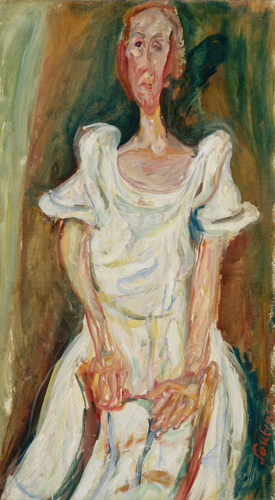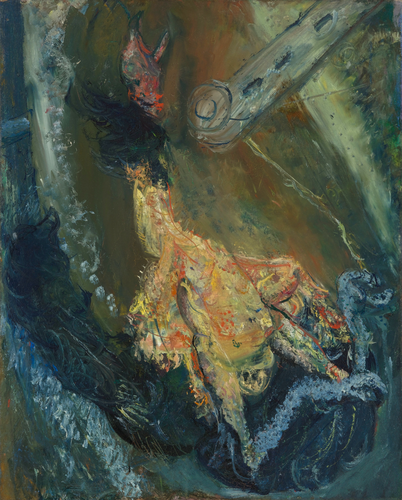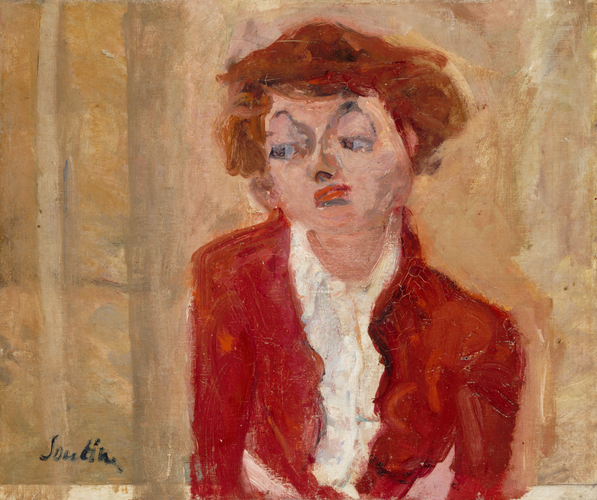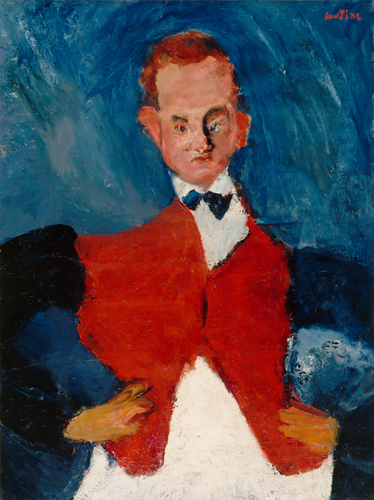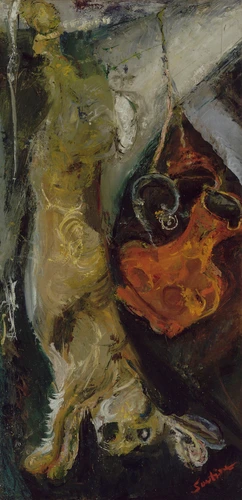Boeuf et tête de veau
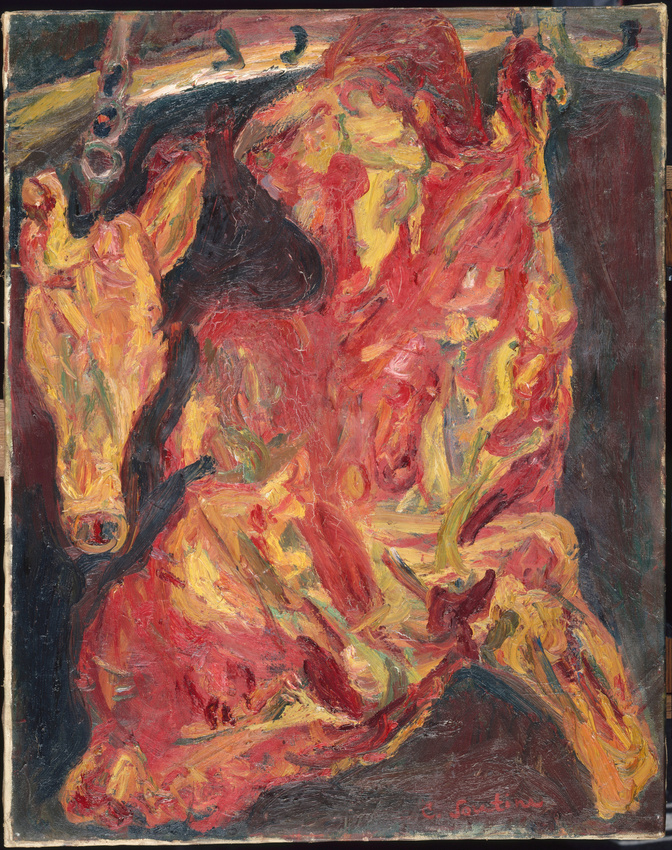
Chaïm Soutine seemed to be fascinated by the subject of the beef carcass, which he depicted on numerous occasions in his paintings. He produced about ten paintings of beef during 1925. At that time, Soutine had a huge studio in the rue du Saint-Gothard, not far from Montparnasse, where he had pieces of animal carcasses delivered, which he would immediately set about painting. The attraction of this motif could have been the result of a traumatic childhood memory. The journalist Emile Szyttia recounted these words spoken by Soutine: "…once I saw the village butcher slice the neck of a goose and drain the blood out of it. I wanted to cry out, but his joyful expression caught the sound in my throat." He later added: "When I painted the beef carcass it was still this cry that I wanted to liberate. I have still not succeeded." In this painting, the beef carcass occupies the majority of the canvas, while, beside it, a calf’s head hangs from a butcher’s hook. The broad brushstrokes in shades of red and yellow depicting the bloody flesh stand out against a plain dark background. As well as childhood memories, we should also point out Soutine’s admiration for the Dutch painter Rembrandt (1606-1669), whose paintings he had admired at the Louvre, particularly his Bœuf écorché [Carcass of Beef] from 1655.
Provenance: Paul Guillaume; Domenica Walter
- collection Paul Guillaume, Paris
- jusqu'en 1963, dans la collection de Mme Jean Walter, Paris
- 1963, acquis de Mme Jean Walter avec le concours de la Société des Amis du Louvre (arrêté d'approbation de la vente du 28/12/1963)
- musée du Louvre, Paris
- 1977, musée de l'Orangerie, Paris, entrée matérielle
- Chaim Soutine (1893-1943) - Tate Gallery - Royaume-Uni, Londres, 1963
- Collection Jean Walter-Paul Guillaume - musée de l'Orangerie - France, Paris, 1966
- La Ruche et Montparnasse (1902-1930) - musée Jacquemart-André - France, Paris, 1978-1979
- Chaim Soutine (1893-1943 ) - Westfalisches Landesmuseum für kunst und kulturgeschichte - Allemagne, Münster, 1981-1982
- Chaim Soutine (1893-1943 ) - Hayward Gallery - Royaume-Uni, Londres, 1982
- Chaim Soutine (1893-1943 ) - Kunstmuseum - Suisse, Lucerne, 1982
- Soutine - musée des Beaux-Arts - France, Chartres, 1989
- Chaim Soutine - museo d'arte moderna - villa Malpensata - Suisse, Lugano, 1995
- An Expressionist in Paris : the Paintings of Chaïm Soutine - Jewish Museum - Etats-Unis, New York, 1998
- Chefs-d'oeuvres du musée de l'Orangerie : collection Jean Walter et Paul Guillaume - Bunkamura Museum of Art - Japon, Tokyo, 1998-1999
- Chefs-d'oeuvres du musée de l'Orangerie : collection Jean Walter et Paul Guillaume - City Art Museum - Japon, Nagoya, 1999
- Chefs-d'oeuvres du musée de l'Orangerie : collection Jean Walter et Paul Guillaume - Prefectural Art Museum - Japon, Hiroshima, 1999
- Chefs-d'oeuvres du musée de l'Orangerie : collection Jean Walter et Paul Guillaume - Niigata City Art Museum - Japon, Niigata, 1999
- Chefs-d'oeuvres du musée de l'Orangerie : collection Jean Walter et Paul Guillaume - National Museum of Modern Art - Japon, Kyoto, 1999
- Chefs-d'oeuvre du musée de l'Orangerie : collection Jean Walter et Paul Guillaume - Taïpei Fine Arts Museum - Taïwan, Province de Chine, Taïpei, 1999-2000
- Chefs-d'oeuvre du musée de l'Orangerie : collection Jean Walter et Paul Guillaume - Kaohsiung Museum of Fine Arts - Taïwan, Province de Chine, Kaohsiung, 2000
- De Renoir à Picasso : chefs-d'oeuvre du musée de l'Orangerie - musée des beaux-arts - Canada, Montréal, 2000
- De Renoir à Picasso : chefs-d'oeuvre du musée de l'Orangerie - Kimbell Art Museum - Etats-Unis, Fort Worth, 2000-2001
- Renoir to Picasso : Masterpieces from the Musée de l'Orangerie - Queensland Art Gallery - Australie, Brisbane, 2001
- Renoir to Picasso : Masterpieces from the Musée de l'Orangerie - Art Gallery of New South Wales - Australie, Sydney, 2001
- Renoir to Picasso : Masterpieces from the Musée de l'Orangerie - National Gallery of Victoria - Australie, Melbourne, 2001
- De Renoir a Picasso : Obres mestres del Musée de l'Orangerie, Paris - CaixaForum - Espagne, Barcelone, 2002
- Modigliani, Soutine et leurs amis de Montparnasse - Magyar Zsidó Múzeum és Levéltár - Hongrie, Budapest, 2003
- L'art de manger - Fundació Catalunya-La Pedrera - Espagne, Barcelone, 2011
- Chaïm Souitne. Retrospective - The Pushkin State Museum of Fine Arts - Russie, Fédération de, Moscou, 2017-2018
- Chaim Soutine: Flesh - Jewish Museum - Etats-Unis, New York, 2018
- De Kandinsky à Kabakov - musée Maillol - France, Paris, 2020-2021
- Soutine / De Kooning - The Barnes Foundation - Etats-Unis, Philadelphie, 2021, cat. 18, p. 92-93 (reprod. coul.)
- Soutine / De Kooning - musée de l'Orangerie - France, Paris, 2021-2022, cat. 18, p. 92-93 (reprod. coul.)
-
Anonyme, Album, [s.n.], *387 *Boeuf — Routhier 387 916 408
-
Walter, Domenica, Classeur Domenica Walter, [s.n.], Fol. 56 verso 916 Boeuf et tête de veau 92 x 73 LOU avec point bleu et rouge souligné en vert Photo collée
-
Walter, Domenica, Classeur, [s.n.], Fol. 56 verso 916 Boeuf et tête de veau 92 x 73 LOU avec point bleu et rouge souligné en vert Photo collée 8
-
Arcangeli, Gaetano, Paragone , n° 33, Corot e Soutine a Venezia, [s.n.], 1952, p. 63, repr. pl. 30 ["Bue scuoiato", "raccolta Walter"]
-
Szittya, Emile, Soutine et son temps, Paris, La Bibliothèque des Arts, 1955, p. 107-108 ["Le boeuf écorché"]
-
Sylvester, David, Art News, vol. 62, n°6, The Impact of Infighting, [s.n.], 1963, n° 12, repr. p. 25 (Boeuf et tête de veau Mme Jean Walter, Paris)
-
Collection Jean Walter-Paul Guillaume, Paris, Réunion des musées nationaux, 1966, n°131, repr. n. p.
-
Lemoyne de Forges, Marie-Thérèse ; Allemand, Geneviève ; Bundorf, Michèle, Collection Jean Walter-Paul-Guillaume : catalogue, Paris, Réunion des musées nationaux, 1966, n° 131, p. 279, repr. p. 278
-
Huyghe, René ; Rudel, Jean, L' Art et le monde moderne 2 vol., Paris, Larousse, 1970, mentionné p. 283
-
Courthion, Pierre, Soutine, peintre du déchirant, Lausanne, Edita, 1972, p. 242 (A), repr. fig. ["Morceaux de boeuf et tête de veau pendus au crochet", "Coll. Jean Walter-Paul Guillaume, Musées Nationaux de France"]
-
Maillard, Robert ; Huyghe, René, Dictionnaire universel de la peinture , 6 tomes, Dictionnaires Robert, 1975, t. 6, mentionné p. 156 [à propos de la série des boeufs écorchés]
-
Warnod, Jeanine, La Ruche & Montparnasse, Paris, Weber, 1978, repr. p. 99
-
Dunow, Esti, Chaïm Soutine , 2 vol., Ann Arbor, UMI (University of Michigan), 1981, n° 101, mentionné p. 186, repr. n.p.
-
Kunz, Martin, Chaim Soutine 1893-1943 : Katalogheft zur Ausstellung Chaim Soutine im Kunstmuseum Luzern, Lucerne, Kunstmuseum, 1982, n° 15, n.p. (Hälfte eines Ochsen und Kopf eines Kalbes)
-
Hoog, Michel ; Guicharnaud, Hélène ; Giraudon, Colette, Musée de l’Orangerie : catalogue de la collection Jean Walter et Paul Guillaume, 3ème éd. revue et mise à jour [1ère éd. 1984], Paris, Réunion des musées nationaux, 1990, n° 120, p. 268, repr. coul. p. 269 (Boeuf et tête de veau )
-
Robert, Paul ; Rey, Alain, Le Petit Robert 2 : dictionnaire universel des noms propres ,, Paris, Le Robert, 1993, mentionné p. 1694
-
Tuchman, Maurice ; Dunow, Esti ; Perls, Klaus, Chaïm Soutine (1893-1943) : Catalogue raisonné, Cologne, Taschen, 1993, n° 98, t. I (II. Natures mortes), p. 470, repr. coul. p. 472 ["Boeuf et tête de veau", "Paul Guillaume, Paris Mme. Jean Walter, Paris ( - / 1963) Musée de l'Ora
-
Georgel, Pierre ; Peng, Chang-Ming, Chefs-d'oeuvre du musée de l'Orangerie : collection Jean Walter et Paul Guillaume., Taïpei, China Times, 1999, n° 79, p. 218, repr. coul. 219
-
Massé, Marie-Madeleine ; Massé, Marie-Madeleine, Soutine, Paris Paris, Skira Flammarion, 2012, p. 19, repr. p. 18, 33, mentionnée p. 32
-
XXVI Biennale di Venezia (cat. exp. 1952, Venise, Palazzo Central), [s.n.], 1952, n° 28, cat. p. 181
-
Cent tableaux de Soutine, cat. exp. (Paris, Charpentier, 1959), [s.n.], 1959, n° 45 (cat. n.p. ["Boeuf et tête de veau", "Collection Mme Jean Walter"])
-
Sylvester, David, Chaïm Soutine, cat. exp. (Londres, Tate Gallery, 1963), Londres, The Arts Council of Great Britain, 1963, n° 28, p. 21-22, repr. pl.18
-
George, Waldemar, L'Héritage de Delacroix, cat. exp. (Paris, Knoedler, 1964), Paris, Galerie Knoedler, 1964, [Identification de l'oeuvre douteuse] (cat. n.p. ["Quartier de boeuf"])
-
Tuchman, Maurice, Chaïm Soutine, 1893-1943, cat. exp. (Los Angeles, County Museum of Art, 1968), Los Angeles, Los Angeles County Museum of Art, 1968, p. 15, 35
-
Leymarie, Jean ; Fontaine, Isabelle ; Bozo, Dominique, Soutine, cat. exp. (Paris, Orangerie des Tuileries, 1973), Paris, Musées Nationaux, 1973, p. 5, 6 (sur les Boeuf en général)
-
Huyghe, René, La Ruche et Montparnasse (1902-1930), cat. exp. (Paris, Musée Jacquemart-André, 1978-1979), Paris, Musée Jacquemart-André, 1978, n° 125 (cat. p. [6|)
-
Güse, Ernst-Gerhard, C. Soutine, 1893-1943, cat. exp. (Münster ; Tübingen ; Londres ; Lucerne, 1981-1982), Londres, Arts Council of Great Britain, 1981, n° 15 (cat. p. 241, repr. 158) Exposé seulement à Münster et Tübingenp. et 73-97, repr. fig. 50 [Morceaux de boeuf et tête de veau pendus au crochet]
-
Vallès-Bled, Maithé, Soutine, cat. exp. (Chartres, musée de Chartres, 1989), Chartres, Musée de Chartres, 1989, n° 44, p. 220, [222], repr. coul. p. 221, [223] (Quartier de boeuf et tête de veau)
-
Chiappini, Rudy ; Wiesel, Elie ; Tassi, Roberto, Chaim Soutine, cat. exp. (Lugano, Museo d'Arte Moderna, 1995), Lugano, Electa, 1995, n° 58, p. 169, repr. p. 169
-
Georgel, Pierre ; Kijima, Shunsuke ; Nagai, Takanori, Chefs-d'oeuvre du musée de l'Orangerie : collection Jean Walter et Paul Guillaume, cat. exp. (Tokyo ; Nagoya ; Hiroshima ; Niigata ; Kyoto, 1998-1999), Tokyo, NTV, 1998, n° 79, p. 182, 219, repr. coul. p. [183]
-
Kleeblatt, Norman L. ; Silver, Kenneth E., An Expressionist in Paris : the Paintings of Chaim Soutine, cat. exp. (New York ; Los Angeles ; Cincinnati, 1998-1999), New York, Prestel, 1998, n° 29, p. 28, 33, 36, repr. coul. pl. 17 p. 177 (Head and Carcass of a Horse ( formerly Side of Beef and Calf's Head))
-
Dunow, Esti ; Matamaros, Josephine ; Giraudon, Colette, Soutine : Céret 1919-1922, cat. exp. (Céret, musée d'art moderne, 2000), Céret, Musée d'art moderne de Céret, 2000, mentionné p. 47, 81, 502, repr. coul. p. 503
-
Georgel, Pierre ; Labiau, Jean-Pierre, De Renoir à Picasso : chefs d'oeuvre du musée de l'Orangerie, cat. exp. (Montréal ; Fort Worth, 2000-2001), Montréal, Musée des Beaux-Arts, 2000, n° 56, p. 212, repr. coul. p. 213
-
Modigliani, Soutine et leurs amis de Montparnasse, cat. exp. (Budapest, Musée Juif Hongrois, 2003), [s.n.], 2003, s.n. (cat. p. 155, repr. coul. pl. 9 p. [51])
-
Giménez, Cristina, El Arte del comer : de la naturaleza muerta a Ferran Adria, cat. exp. (Barcelone, La Perdrera-Casa Milà, 2011), Barcelone, Fundacio Caixa Catalunya, 2011, Giménez, 2011, p. 48 et mentionné p. 81, 243, repr. coul. p. 81
-
Tuchman, Maurice ; Dunow, Esti, Chaïm Soutine / Francis Bacon, cat. exp. (New York, Helly Nahmad Gallery, 2011), Helly Nahmad Gallery, 2011, Tuchman et Dunow, 2011, repr. coul. p. 29
-
Vial, Marie-Paule ; Bernardi, Claire, Chaïm Soutine, cat. exp. (Paris, musée de l'Orangerie, 2012-2013), Paris, Musée d'Orsay, 2012, Vial et Bernardi,2012, n° 43, p. 124 et mentionné p. 170, repr. coul. p. 124
-
Soutine, cat. exp. (Moscou, Musée Pouchkine, 24 octobre 2017-21 janvier 2018), Moscou, Musée Pouchkine, 2017, repr. coul. p. 98
-
Chefs-d'oeuvre du Musée de l'Orangerie, collection Jean Walter et Paul Guillaume, cat. exp. (Yokohama Museum of Art, 21 septembre 2019-13 janvier 2020), Yokohama, Yokohama, Yokohama Museum of Art, 2019, n° 66, p. 140, ill. en coul.
Do you have a question where you have additional knowledge about this work? You can write to us to suggest improvements to the file.
Make a suggestion